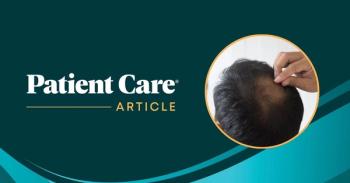
Combination Therapies for Dermatomyositis: An Emerging Consensus
What are the latest recommendations concerning the treatmentof dermatomyositis?
What are the latest recommendations concerning the treatmentof dermatomyositis?
-- Maria Demkowicz, MD
Olney, MdStandard drug therapy for adult dermatomyositisand other forms of inflammatory myositis includescorticosteroids, methotrexate, and azathioprine.Oral prednisone, 0.75 to 1 mg/kg/d or 40 to 80mg/d, is the recommended first-line treatment.However, while 60% to 80% of patients show partial improvementwith corticosteroid therapy, only about one thirdachieve complete remission.Most patients require combination therapy with bothcorticosteroids and a second-line cytotoxic drug, such asPO methotrexate (7.5 to 25 mg weekly), azathioprine (1 to3 mg/kg/d or 50 to 150 mg/d), or cyclosporine (2.5 to7.5 mg/kg/d). Such a regimen is indicated particularly forthe following patients:
- Those with corticosteroid-resistant myositis (who, after4 to 8 weeks, have failed to respond to prednisone dosagesof 0.75 mg/kg/d or higher).
- Those with comorbid conditions exacerbated by prolongedhigh-dose corticosteroid therapy, such as diabetes,heart failure, or hypertension.
- Those who experience a flare of myositis when the corticosteroiddosage is tapered.
- Those with major corticosteroid complications, such as diabetes,Cushing syndrome, hypertension, or osteoporosis.
Early use of combination therapy is especially recommendedfor patients in whom diagnosis or initiation oftreatment was delayed, as well as those with the followingconditions:
- Severe dermatomyositis or polymyositis.
- Profound weakness and anti-signal recognition proteinantibodies or anti-Jo antibodies.
- Significant myositis-associated interstitial pulmonarydisease, myocarditis, or dysphagia.
In recent years, a number of alternative treatmentstrategies and investigational therapies have been advocated,particularly in patients with refractory dermatomyositisor polymyositis and in those with interstitialpulmonary disease, myocarditis, esophageal dysmotility,or cutaneous dermatomyositis lesions. These therapiesinclude:
- Low-dose corticosteroids (prednisone, 0.5 mg/kg/d or7.5 to 30 mg/d) in combination with oral methotrexate,azathioprine, or cyclophosphamide.
- Intermittent megadose IV pulse corticosteroid therapy(methylprednisolone, 15 to 30 mg/kg/d or 500 to 1000 mg/dfor 3 days per month for 3 to 6 months) combined withmethotrexate or another cytotoxic drug.
- Combination therapy with corticosteroids and bothmethotrexate (7.5 to 25 mg/wk) and azathioprine (50 to150 mg/d).
- Therapy with both PO cyclosporine (2.5 to 7.5 mg/kg/d)and prednisone.
- IV immunoglobulin (1 g/kg/d infused over 8 to 12 hoursfor 2 successive days per month for 4 to 6 months) in combinationwith corticosteroid therapy (recommended particularlyfor patients with refractory dermatomyositis).
- Tacrolimus (FK506), 0.075 mg/kg/d PO.
- Fludarabine (20 mg/m2 of body surface area/d PO for3 days per month for 6 months).
- IV pulse cyclophosphamide, 0.5 g/m2 of body surfacearea every 4 weeks for 9 cycles (recommended particularlyfor patients with treatment-resistant, myositis-relatedinterstitial pulmonary disease).
- Mycophenolate mofetil, 1000 to 2000 mg/d; hydroxychloroquine,200 to 400 mg/d; or low-dose IV immunoglobulin,0.1 g/kg/d for 5 successive days a week for 2weeks (recommended especially for patients with dermatomyositisand cutaneous lesions refractory to bothcorticosteroids and cytotoxic drugs).
Biologic agents, including the anti-tumor necrosis factordrugs etanercept and infliximab. Preliminary studies suggestthat these drugs may be effective in patients with idiopathicmyositis refractory to corticosteroids, methotrexate,azathioprine, and/or cyclosporine.There is little recent experience with such old-linetherapies as total lymphoid irradiation, apheresis (plasmapheresisor leukapheresis), and chlorambucil. Considerthese only in patients with severe intractable dermatomyositisor polymyositis.A consensus is emerging in favor of the early use ofcombination therapies in the management of idiopathicinflammatory myositis, including dermatomyositis. However,adverse drug reactions are relatively frequent withsuch therapies, and recovery of muscle function is oftenincomplete. Research is needed to develop more effectivepharmacotherapies with fewer side effects.
-- Adel G. Fam, MD
Professor of Medicine
University of Toronto
References:
FOR MORE INFORMATION:
- Fam AG. Recent advances in the management of adult myositis. Expert OpinInvestig Drugs. 2001;10:1265-1277.
- Oddis CV. Current approach to the treatment of polymyositis and dermatomyositis.Curr Opin Rheumatol. 2000;12:492-497.
- Qushmaq KA, Chalmers A, Esdaile JM. Cyclosporin A in the treatment of refractoryadult polymyositis/dermatomyositis: population based experience in 6 patientsand literature review. J Rheumatol. 2000;27:2855-2859.
- Villalba L, Hicks JE, Adams EM, et al. Treatment of refractory myositis. A randomizedcrossover study of two new cytotoxic regimens. Arthritis Rheum. 1998;41:392-399.
Newsletter
Enhance your clinical practice with the Patient Care newsletter, offering the latest evidence-based guidelines, diagnostic insights, and treatment strategies for primary care physicians.






























































































































































































































































































































